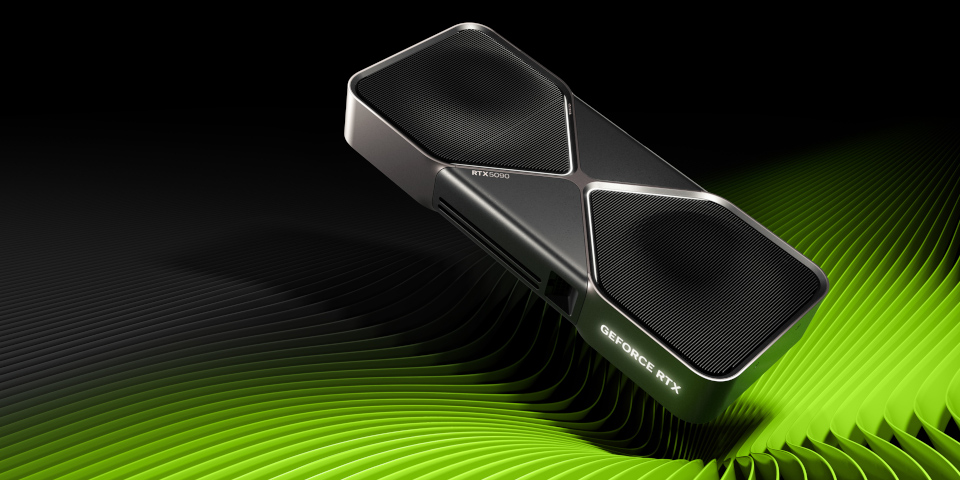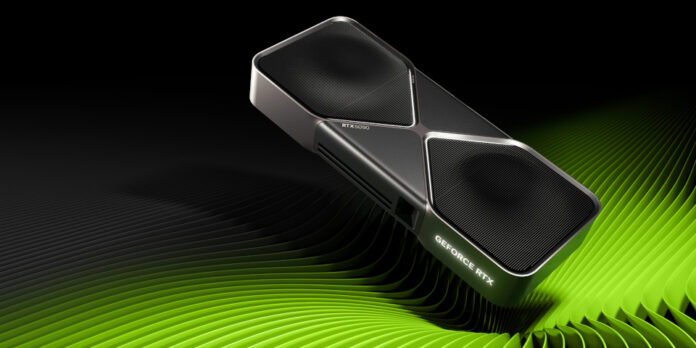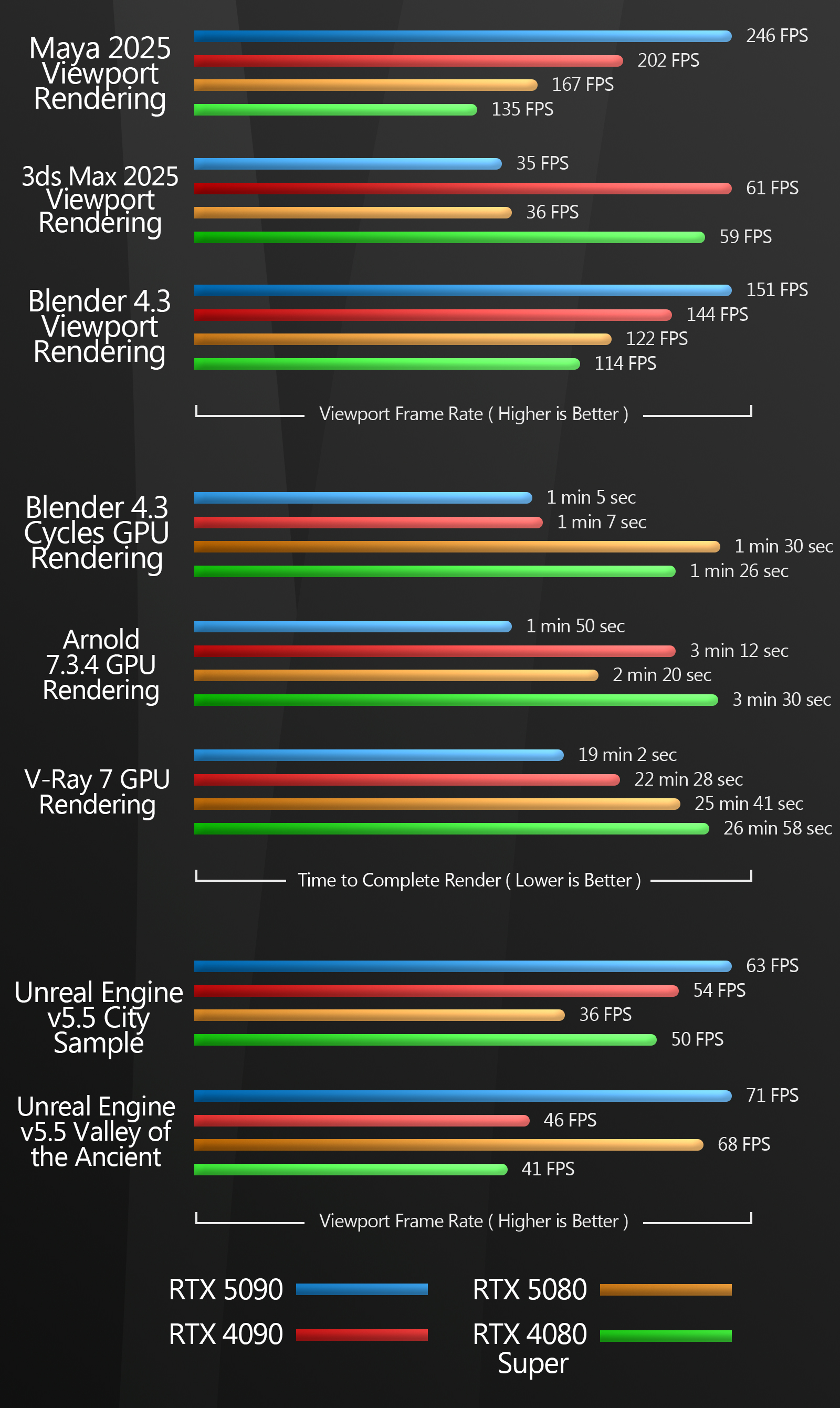
The first NVIDIA GeForce RTX 50 Series GPUs are now available. Ahead of a longer review, CG Channel’s hardware expert Jason Lewis sets out his early benchmark test results for the GeForce RTX 5090 and 5080 in CG apps including 3ds Max, Blender, Maya and Unreal Engine.
Last week saw the launch of the GeForce RTX 5090 and GeForce RTX 5080, the first cards from the GeForce RTX 50 Series, NVIDIA’s new consumer GPUs based on its Blackwell architecture.
Since then, there have been quite a few online reviews of the new GPUs, most focused on gaming, and a few on AI workloads. But how do they perform in DCC and graphics workflows?
Well, I have also begun testing the GeForce RTX 5090 and 5080 with a handful of popular DCC applications, and have some quick-and-dirty early test results that I can share with you here.
Technical specifications
I tested the new GPUs against the equivalent cards from the Ada-generation GeForce RTX 40 Series GPUs, the GeForce RTX 4090 and GeForce RTX 4080 Super.
Here’s how the GeForce RTX 5090 and GeForce RTX 5080 stack up on paper against their previous-gen counterparts.
| NVIDIA’s GeForce RTX 50 Series GPUs and previous-gen counterparts | |||||
|---|---|---|---|---|---|
| RTX 5090 | RTX 4090 | RTX 5080 | RTX 4080 Super |
||
| Architecture | Blackwell | Ada Lovelace | Blackwell | Ada Lovelace | |
| CUDA cores | 21,760 | 16,384 | 10,752 | 10.240 | |
| Tensor cores* | 680 | 512 | 336 | 320 | |
| RT cores* | 170 | 128 | 84 | 80 | |
| Base clock (GHz) | 2.01 | 2.23 | 2.30 | 2.29 | |
| Boost clock (GHz) | 2.41 | 2.52 | 2.62 | 2.55 | |
| Compute performance FP32 (Tflops)* |
104.8 | 82.6 | 56.3 | 52.2 | |
| GPU memory | 32 GB GDDR7 | 24GB GDDR6X |
16 GB GDDR7 | 16GB GDDR6X |
|
| TGP | 575W | 450W | 360W | 320W | |
| Release date | 2025 | 2022 | 2025 | 2024 | |
| MSRP at launch | $1,999 | $1,599 | $999 | $999 | |
*Data taken from third-party websites.
Testing process
For my early tests, I used the same test rig and benchmark scenes as my most recent group test of GeForce RTX 40 Series GPUs, updated to the current versions of the software.
Before we get to the actual test results, I want to reiterate something that many of you will already know: that hardware development almost always outpaces software development.
Professional graphics applications evolve quite slowly in comparison to games and other consumer applications, and it takes some time for CG software to reach the level of optimization that really allows it to take advantage of new GPU architectures.
Benchmarks and performance in DCC applications
As you can see, the early test results are all over the place. In some tests, the GeForce RTX 5090 and 5080 are significantly faster than their previous-generation counterparts, but in some they are only slightly faster, and in a few, they are actually slower.
So what does this mean? Most other early reviewers have concluded that both NVIDIA’s GPU drivers and the software they are used with require updates before we can assess the true performance of the new GPUs, and I believe that we’re in the same boat.
I will be doing much more extensive testing of these new GPUs in the coming weeks, then providing a comprehensive review, and I hope to have a clearer picture by then.
Early availability
One last thing I want to talk about is the current availability of the GeForce RTX 5090 and 5080.
Many reviewers, myself included, believe that last week was really a paper launch for the GPUs, since there is currently very little availability in retail channels.
Some retailers estimate that it could take several months for supply to catch up with demand, and while gamers are understandably upset about this, it’s much less of an issue for CG artists.
By the time the new GPUs are back in full supply, the drivers should have matured, and graphics software should be able to take better advantage of their potential.
Many DCC software developers release major new versions of their software in mid-spring, so it will be interesting to see how those new versions fare with the Blackwell GPUs.
Find specifications for the GeForce RTX 50 Series GPUs on NVIDIA’s website
Have your say on this story by following CG Channel on Facebook, Instagram and X (formerly Twitter). As well as being able to comment on stories, followers of our social media accounts can see videos we don’t post on the site itself, including making-ofs for the latest VFX movies, animations, games cinematics and motion graphics projects.


